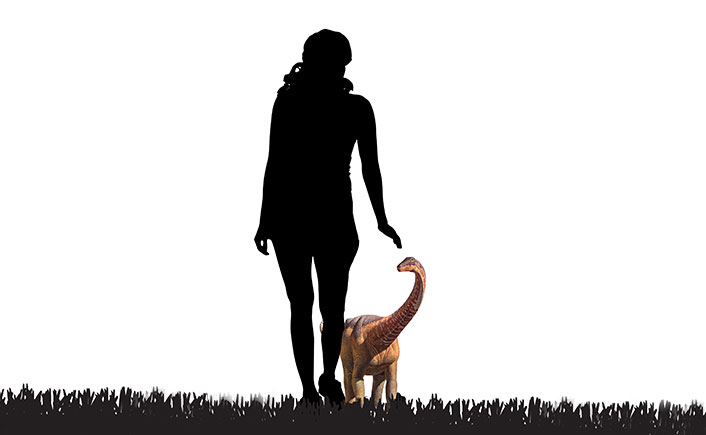Fossils Of Baby Dinosaur Reveal Neglect

Baby Rapetosaurus were only dog-sized a few weeks after hatching. As adults, they outweighed elephants.
R. Martin and K. Curry Rogers
(Inside Science) -- The largest dinosaurs that ever walked the Earth didn't care for their young. These sauropods, which sometimes extended beyond 100 feet long from long neck to sprawling tail, apparently laid their eggs and walked away, leaving their offspring to fend for themselves. It's a reproductive strategy that can turn out badly.
The discovery of a baby dinosaur in Madagascar who starved to death 67 million years ago just after hatching, shows that the reptile was what scientists call precocious. They emerged from their shells totally independent, ready to forage for food, and grew at a prodigious rate. Or, in the case of the dinosaur found by paleontologist Kristina Curry Rogers, a vertebrate paleontologist at Macalester College in St. Paul, Minnesota, they died.
It was a rare find.
"I finally found a sauropod you can carry in one hand," she said.
The dinosaur lived just before the mass extinction of the Cretaceous Period. Rogers reported her findings in a paper published in Science this week along with colleagues from the University of Washington, Seattle, the University of Minnesota, Minneapolis, and Adelphi University in Garden City, New York.
About 15 years ago, Rogers discovered the first example of the species called Rapetosaurus krausei. The name came from a mischievous Madagascar legendary creature whose antics included stepping on houses. The second name was from a Stony Brook University professor, David Krause.
This dinosaur species had a very long neck and a relatively short tail. They have been found all over the world.
The site where Rogers worked in Madagascar included hundreds of bones, from multiple skeletons. There are Rapetosaurus skeletons at various museums, but this is the first baby Rapetosaurus found.
The hundreds of bones from the dig were shipped to Stony Brook and many were put in a drawer. Rogers found the little ones for the baby dinosaur when going through the drawers. They were hidden under some larger bones.
The baby's remains consisted of 15 or 18 individual bones, a good representation of the limbs, pelvis, and feet, and some from the base of the tail. The femur of the full grown dinosaur, she said, are bigger than she is, but these were small bones were small enough to be stored in a drawer. She could identify the species because they were "anatomically indistinguishable" from Rapetosauruses.
There were not enough bones to tell if it was male or female.
From looking at calcification at the ends of the bones, she could tell the animal died of starvation. What was most interesting, she said, was that the limbs appeared to grow isometrically, meaning they were in the same shape when the dinosaur was born as they would be when it grew.
"Shape is maintained throughout all of life history," she said. In many animals, limbs change as they mature.
"We think that if an animal is going to gain a lot of body mass as it grows that the bones may change because of that increase in loading. In these bones you can see they are similar, whether the animals are tiny or huge. The bones in the baby Rapetosaurus are over-engineered."
And when these animals grew, they grew astonishingly fast. Rogers said the dinosaur probably weighed about seven-and-a-half pounds at birth. Several weeks later, when it died, it weighed 88 pounds.
A full grown Rapetosaurus was about the size of a school bus, she said, and would be 40 or 50 feet long, and weigh almost as much as three elephants. The increase in growth was extraordinary.
Luis Chiappe, director of the Dinosaur Institute of the Museum of Natural History of Los Angeles, said that a newborn Rapetosaurus would have been about the same weight as a newborn human but grew to several tons in the same amount of time it takes a human to reach full adult size. The fact the limbs were isometric meant the baby dinosaur was precocious.
Animals, he said, are divided into two strategies for reproduction. One group, including humans, apes, and whales, have very few babies, all of them helpless at birth, and tend to them for years until they can grow big enough and wise enough to take care of themselves.
The second, the precocious group, have multiple offspring who are born totally independent, such as sea turtles and snakes. The mother gives birth or lays eggs and leaves them to fend for themselves. Infant mortality is high. The Rapetosaurus was clearly of the second group, and this one did not make it.
Chiappe studied this species in Patagonia, on the southernmost tip of South America. In the days of the dinosaurs, the continents were connected, which explains why Rapetosauruses could be found in Madagascar and Patagonia. They found embryos as well. Some of the dinosaurs were found in New Mexico and Texas, he said.
He was surprised Rogers and her colleagues found isometric growth in the baby dinosaur. That is unusual in the animal world.

